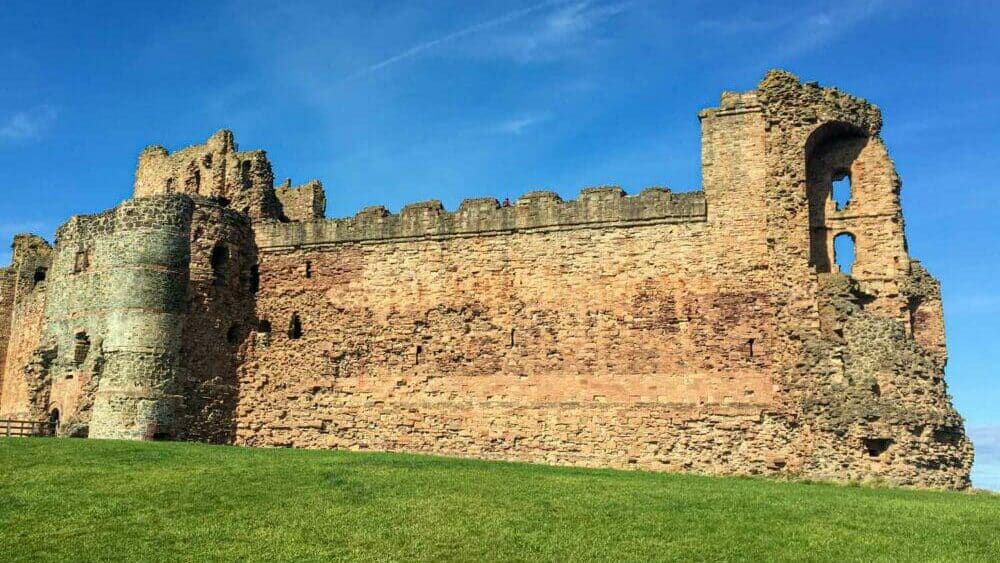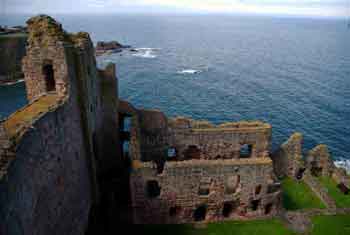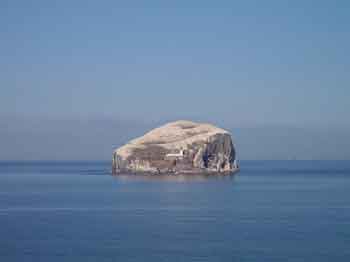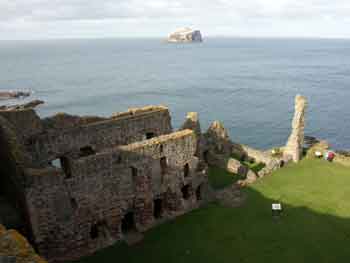Tantallon Castle, one of the most exposed castles in Scotland, sits high on a windy coastal headland, close to the small town of North Berwick,

The castle, a Historic Environment Scotland property, lies about 25 miles from Scotland’s capital city. Its location offers spectacular views of the Bass Rock.
The castle is protected on three sides by the cold waters of the Firth of Forth. On its only exposed flank, to the south west, this “last truly great castle built in Scotland” is embraced by its mighty, and still relatively intact, red sandstone 12 feet thick curtain wall, which rises to over 50 feet in height.
Scotland’s last great medieval castle was said by some to be the inspiration for King Arthur’s Camelot.
It was built in an age when its lofty towers and mighty curtain wall were required only to withstand the stone-throwing medieval siege engine and battering rams of unwelcome visitors.
Tantallon Castle: Douglas Tower
Three towers, which provided the bulk of the residential accommodation, form part of this impressive wall.
The East Tower, which suffered badly in the 1651 siege, the central tower which provided the gateway to the castle and the north tower, better known as the Douglas Tower, with its seven floors almost certainly provided the earl’s living quarters.
It’s further protected by extensive earthworks probably constructed to withstand the cannon of James V, in 1528.
For around 300 years Tantallon was the stronghold of the Douglases, one of Scotland’s greatest dynastic families.
It was on the orders of William Douglas gave the order that building work on the castle began during the 1350s.
However, there is some debate as to whether construction work began before or after he was created the first Earl of Douglas in 135
Pit prison
With the earldom came the responsibility for governing the local area. That included collecting rent, ensuring the law was upheld and holding trials when necessary.
For local people, those who fell foul of the regime, Tantallon’s notorious Pit Prison awaited.

Brothers Robert and William Chambers editors of Chambers’ Journals described the Pit Prison as, “a hideous cavern, arched overhead, dank and dripping with an opening towards the sea which dashes to within a few feet below.”
For the nobility who incurred the Douglas wrath, incarceration wasn’t in the castle’s dungeon but within the main castle.
It was still a prison but in a room with a view.
The first Earl of Douglas was an important member of a powerful extended clan.
He was the son of Sir Archibald Douglas, Guardian of Scotland and nephew of the Good Sir James Douglas, a trusted man who stood alongside Robert the Bruce at Bannockburn.
Following Bruce’s death in June 1329, Douglas took the king’s heart to the Holy Land, only to be killed by Moorish forces at the Battle of Teba in Andalusia, Spain.
Bruce’s heart was finally interred at the great Cistercian abbey at Melrose in the Scottish Borders.
Despite this illustrious heritage, by the early 15th century, relationships within the family broke down with two opposing factions emerging, the Black Douglases and the Red Douglases.
It was the Red Douglases, who took the title the Earls of Angus and held sway at Tantallon. Their constantly shifting loyalties were a formidable and constant thorn in royal sides.
In three centuries of occupation, as in the rest of Scotland, personal or family rivalries resulting in conflict often took precedence over political debate as a way to advance a cause.
Consequently, a steady succession of intrigues, skirmishes and soured relations meant life at the castle was rarely dull.
However, within this seemingly unending series of events, a number of particularly significant incidents stand out.
Battle of Sauchieburn
By 1491, James III was dead, killed at the Battle of Sauchieburn three years earlier and Tantallon was under siege.
Its incumbent, the fifth Earl of Angus had treacherously plotted with England’s King Henry VII the deliver the young and inexperienced James IV into his hands.
Such disloyalty, when discovered, brought the king and the artillery train from Edinburgh Castle to the gates of Tantallon.
In the end, little damage was done and relations between the king, who took a pragmatic view, and the earl were subsequently mended.
Certainly, Henry took a keen interest in the young Scottish king, later agreeing to the marriage of his eldest daughter Margaret Tudor to him, an alliance that ultimately led to the Union of the Crowns in 1603.
Interestingly castle records show that, as a token, James also sent Angus a Christmas gift of a black velvet gown lined with lamb’s wool.
Following the death of James IV at Flodden in 1513 his widow Margaret married Archibald Douglas the sixth Earl of Angus. Their infant son was proclaimed King James V.
Captivity in Falkland Palace
James V’s minority accession to the throne created a power struggle among Scottish nobles. Initially, his mother was nominated as regent but was later replaced by the staunchly pro-French John Stewart, the Duke of Albany who remained in control until 1524.
With Albany gone, Angus, now separated from his wife, seized the opportunity and kidnapped James, holding him hostage until 1528.
When he finally escaped from his captivity in Falkland Palace he headed for the great castle at Stirling.

The chronicler Robert Lindsay of Pitscottie, Historie and Chronicles of Scotland, said that the Earl of Angus, “rullit the king as he pleissit and caussit him to ryde throw all the pairtis of Scotland under the pretence and collour of justice…”
At only 16 James was now king in his own right and unsurprisingly Douglas was summonsed for treason.
But in his absence, his lands were forfeited at a parliament held in Edinburgh on 5 September 1528.
The king then began a largely unsuccessful campaign against several Douglas strongholds including Tantallon Castle.
Tantallon siege 1528
James V led the 1528 Tantallon siege, taking with him two great cannons and other weapons borrowed from the Duke of Albany at nearby Dunbar Castle.
Pitscottie described the armaments as, “thrown mouthed mow and her marrow (partner) with two great botcords and two moyans, two double falcons and four quarter falcons with powder and bullets were.
Pitscottie also tells us that three lords were left in pledge to ensure a safe return of the guns.
Regardless of the king’s artillery, Tantallon, although damaged, only capitulated after agreement was reached, in the absence of Angus, with the governor Simon Panango.
The sixth Earl of Angus finally left Scotland in May 1529 for exile in England.

James V died in December 1542 soon after the Scottish defeat at the Battle of Solway Moss.
His new born daughter Mary Queen of Scots was only six days old. With his death, the Douglases once again took control of the castle.
Following Scot’s catastrophic defeat by Oliver Cromwell at the Battle of Dunbar in 1650, a small group of Moss-troopers desperate to continue the fight took refuge in the castle.
A force under General George Monk later created the 1st Duke of Albemarle; one of Cromwell’s most loyal and trusted commanders was dispatched to bring an end to the occupation.
Douglas and East Towers destroyed
During a 12 day bombardment, in which much of the Douglas and East Towers were destroyed, the besieged royalists put up such a determined resistance Monk allowed them to surrender.
Sir Walter Scott subsequently talked eloquently about the castle’s impregnability in war.
However, despite additional defences built in the 16th century, specifically to withstand cannon fire, Monk’s offensive was the final and most destructive siege at this ancient bastion which was never lived in again.
In 1699, James Douglas, 2nd Marquess of Douglas and 12th Earl of Angus, in order to pay his gambling debts, sold the castle to Hew Dalrymple, Lord North Berwick.
F.H. Groome Ordnance in the Gazetteer of Scotland said Douglas, “dismantled it and gave it up to decay.” Finally, in 1924 the state took responsibility for its care.
Society of Antiquaries of Scotland
A 1991 report from the Society of Antiquaries of Scotland allows researchers a glimpse of some of the medieval and later finds from a number of archaeological excavations carried out since World War One.
Inevitably a number of the finds are of a military nature. Some of the flattened shot.
Some of this was tentatively associated with two of the most notable sieges of the castle: the failed attempt by King James V in 1528 and the successful attack by Cromwellian forces, in 1651.
The report makes an interesting summary of the different types of shot found at the castle, including the ones fired using gunpowder and those fired using some type of throwing device.
Some interesting bullets, specially adapted to fire in rapid succession from one barrel, were uncovered too. A find which prompted a debate as to what kind of weapon could have fired such a projectile.
The report, while acknowledging that it was impossible to date the bullets, said, “The size of the shot from Tantallon makes it unlikely that they could have been fired from a hand-held gun without any support.
“They may have been used with multiple-barrelled pieces mounted on wheels or tripods.”
Historic Scotland’s Chris Tabraham, said, “Tantallon Castle was quite exceptional and we shall never know what motivated the Earl of Douglas to build in this manner and on the scale that he did. In doing so he was out of step with his peers…”
Tantallon Castle: visitor information
For information on opening hours, cost of entry and other tips to help you plan your visit, go to the official castle website.
REFERENCES: Further RESEARCH AND DATA
- SIMPSON, W.D., 1927. The Architectural History of Dirleton Castle. Transactions of the Glasgow Archaeological Society, 8(1), pp.1-31.
- Caldwell, D.H. and O’Neil, M., 1992, November. Tantallon Castle, East Lothian: a catalogue of the finds. In Proceedings of the Society of Antiquaries of Scotland (Vol. 121, pp. 335-357).
- Day, T.C., 1928. The volcanic vents on the shore between North Berwick and Tantallon Castle. Transactions of the Edinburgh Geological Society, 12(1), pp.41-52.